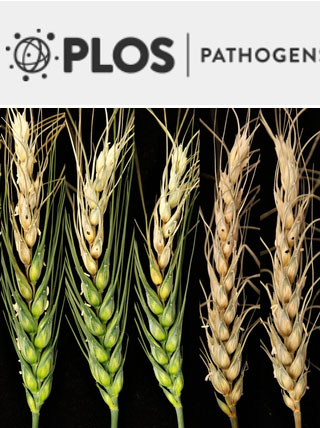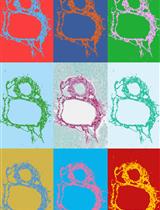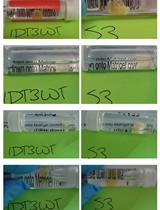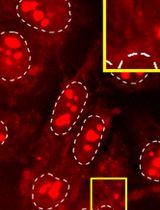- EN - English
- CN - 中文
In situ Hybridization of Plant-parasitic Nematode Globodera pallida Juveniles to Detect Gene Expression
原位杂交检测马铃薯白胞囊线虫的基因表达
发布: 2019年09月20日第9卷第18期 DOI: 10.21769/BioProtoc.3372 浏览次数: 4938
评审: Demosthenis ChronisKrzysztof WieczorekAnonymous reviewer(s)
Abstract
In this study, we describe a standard whole mount in situ hybridization method which is used to determine the spatial-temporal expression pattern of genes from Globodera spp. Unlike more invasive radioactive labeling approaches, this technique is based on a safe, highly specific enzyme-linked immunoassay where a Digoxigenin (DIG)-tagged anti-sense probe hybridized to a target transcript is detected by anti-DIG antibodies conjugated with alkaline phosphatase enzyme (AP) (anti-DIG-AP). The hybrid molecules are visualized through an AP-catalyzed color reaction using as the substrate 5-bromo-4-chloro-3-indolyl phosphate (BCIP) and nitro blue tetrazolium chloride (NBT). This method can be applied to both free-living pre-parasitic juveniles and early endoparasitic stages of cyst nematodes.
Keywords: In situ hybridization (原位杂交)Background
Potato cyst nematodes (PCNs), Globodera pallida and G. rostochiensis, are a global threat to a potato production, causing in excess of 80% yield loss in infested fields (Brodie, 1989). PCNs are highly specialized sedentary endoparasites undergoing a complex life cycle with six developmental stages: egg, four juvenile stages, and male or female adult. The second stage juveniles (J2) hatched from eggs in soil are free-living mobile pre-parasitic nematodes that recognize and invade plant roots. After reaching cells in the root vascular cylinder, J2s become sedentary, feed and molt into third and fourth parasitic stage (J3 and J4, respectively). To complete their life cycle, nematodes undergo sexual differentiation into males and females. Following sexual reproduction, eggs are laid within the female body which eventually becomes a cyst. One way to understand this complex life cycle, is to use the in situ hybridization technique to monitor in vivo spatial gene expression at different nematode developmental stages to gain insight into the function of those genes. The in situ hybridization is a highly specific and sensitive assay based on the immunodetection of DIG-tagged probes hybridized to a target transcript. First, the polymerase chain reaction (PCR) is used to generate labeled probes through randomly incorporating DIG-coupled dUTP during enzymatic amplification of the cDNA template. Second, biological samples are fixed, mechanically cut, enzymatically permeabilized, and incubated with DIG-labeled probes for hybridization. Finally, hybridized probes are selectively detected by anti-DIG antibodies conjugated with alkaline phosphatase enzyme (anti-DIG-AP). AP catalyzes a color reaction using the substrate BCIP and NBT to visualize targeted hybrid molecules. Described here, the in situ hybridization protocol has been adapted from de Boer et al. (1998) and optimized for Globodera spp. Although this method has been routinely used to confirm esophageal gland expression of nematode effector genes, it can be applied to detect the expression pattern of any other nematode gene (Jones et al., 2002).
Materials and Reagents
- Laboratory gloves
- RNaseZap® RNase Decontamination Wipes (Thermo Fisher Scientific, catalog number: AM9786)
- 15 ml glass tubes
- 0.5 ml and 1.5 ml nonstick microcentrifuge tubes (e.g., VWR, catalog numbers: 20170-315 and 20170-650)
- 0.2 ml PCR tubes (e.g., Thermo Fisher Scientific, catalog number: E0030124707)
- Microscope slides and coverslips (e.g., Thermo Fisher Scientific, catalog numbers: 12-550-A3 and 10-016-24)
- Razor blades (e.g., Thermo Fisher Scientific, catalog number:12-640)
- Filtered DNase free tips (e.g., Mettler-Toledo, Rainin, catalog numbers: 17007957, 17002927, 17014361)
- Nuclease-free water (e.g., Thermo Fisher Scientific, catalog number: AM9937)
- Taq PCR polymerase (New England BioLabs, catalog number: M0273S)
- Deoxynucleotides (dNTPs) (Thermo Fisher Scientific, catalog number: 10297117)
- Forward and reverse primers for in situ hybridization probes (e.g., Sigma-Aldrich)
- PCR Purification Kit (e.g., ZYMO RESEARCH, catalog number: D4033)
- Digoxigenin (DIG) DNA Labeling Mix (Roche Diagnostics, catalog number: 11277065910)
- Proteinase K 20 mg/ml (Roche Diagnostics, catalog number: 03115887001)
- Boehringer blocking reagent (Roche Diagnostics, catalog number: 11096176001)
- Anti-Digoxigenin-AP-Fab fragments (Roche Diagnostics, catalog number:11093274910)
- 5-bromo-4-chloro-3-indolyl-phosphate, 4-toluidine salt BCIP (Roche Diagnostics, catalog number: 11383221001)
- 4-Nitro blue tetrazolium chloride NBT (Roche Diagnostics, catalog number: 11383213001)
- DNA sodium salt from salmon testes (Sigma-Aldrich, catalog number: D1626)
- tRNA from baker’s yeast (Sigma-Aldrich, catalog number: R8759, type X-SA)
- Denhardt’s solution 50x (Sigma-Aldrich, catalog number: D2532)
- Dry ice
- Sucrose (e.g., Sigma-Aldrich, catalog number: S0389)
- Agarose (e.g., VWR, catalog number: 0710)
- Potassium phosphate monobasic (KH2PO4) (e.g., Sigma-Aldrich, catalog number: P9791)
- Sodium phosphate dibasic (Na2HPO4) (e.g., Sigma-Aldrich, catalog number: S7907)
- Sodium chloride (NaCl) (Sigma-Aldrich, catalog number: S7653)
- Sodium citrate (Na3C6H5O7) (Sigma-Aldrich, catalog number: 1613859)
- Magnesium chloride hexahydrate (MgCl2·6H2O) (Sigma-Aldrich, catalog number: 63138)
- 0.5 M EDTA pH 8 (Sigma-Aldrich, catalog number: 324504)
- Tris-base (Sigma-Aldrich, catalog number: T1503)
- Tween-20 (Sigma-Aldrich, catalog number: P1379)
- Acetone (Sigma-Aldrich, catalog number: 650501)
- Methanol (Sigma-Aldrich, catalog number: 34860)
- 37% formaldehyde solution (Sigma-Aldrich, catalog number: F15587)
- Maleic acid (Sigma-Aldrich, catalog number: M0375)
- SDS (Sigma-Aldrich, catalog number: 1614363)
- Formamide deionized (Sigma-Aldrich, catalog number: F9037)
- Hydrochloric acid (HCl) (Sigma-Aldrich, catalog number: H1758)
- Transparent nail polish (e.g., Pure Ice)
- Globodera pallida–pre-parasitic J2s (10,000) or parasitic stages (> 100)
- M9 buffer (see Recipes)
- Fixation Buffer (see Recipes)
- 20x SSC (see Recipes)
- Hybridization Buffer (see Recipes)
- Washing Buffer A (see Recipes)
- Washing Buffer B (see Recipes)
- Maleic Acid Buffer (see Recipes)
- Blocking Buffer (see Recipes)
- Detection Buffer (see Recipes)
Note: Recipes for in situ hybridization buffers can be found at the end of this protocol.
Equipment
- Pipets (e.g., Rainin, models: P2, P20, P200, P1000)
- Sieve of 2.8 mm/500 μm/250 μm/90 μm/25 μm/20 μm (e.g., Humboldt, catalog numbers: No. 7, 35, 60, 170, 500, 635)
- PCR thermocycler (e.g., Bio-Rad, model: T100)
- DNA electrophoresis system (e.g., Bio-Rad) and imaging system (e.g., Azure Biosystems, model: c300)
- NanoDrop (e.g., Thermo Fisher Scientific, model: 2000 Spectrophotometer)
- Centrifuge for 15 ml glass tubes (e.g., Eppendorf, model: 5804 R)
- Laboratory blender (e.g., Waring, model: WF2211214)
- Microcentrifuge for 0.5 ml and 1.5 ml tubes (e.g., Eppendorf, model: 5424)
- Tube rotator (e.g., Thermo Fisher Scientific, catalog number: 88881001)
- 4 °C Fridge
- -20 °C Freezer
- Hybridization oven (e.g., VWR, model: 230402V)
- Mini block heater (e.g., VWR, model: 10153-318)
- Light Inverted Microscope (Leica, model: DMi8)
Software
- Microscope imagining software–LAS V4.12 (Leica, https://www.leica-microsystems.com/products/microscope-software/p/leica-application-suite/)
Procedure
文章信息
版权信息
© 2019 The Authors; exclusive licensee Bio-protocol LLC.
如何引用
Kud, J., Solo, N., Caplan, A., Kuhl, J. C., Dandurand, L. and Xiao, F. (2019). In situ Hybridization of Plant-parasitic Nematode Globodera pallida Juveniles to Detect Gene Expression. Bio-protocol 9(18): e3372. DOI: 10.21769/BioProtoc.3372.
分类
分子生物学 > DNA > DNA 标记
细胞生物学 > 细胞成像 > 固定组织成像
您对这篇实验方法有问题吗?
在此处发布您的问题,我们将邀请本文作者来回答。同时,我们会将您的问题发布到Bio-protocol Exchange,以便寻求社区成员的帮助。
提问指南
+ 问题描述
写下详细的问题描述,包括所有有助于他人回答您问题的信息(例如实验过程、条件和相关图像等)。
Share
Bluesky
X
Copy link














